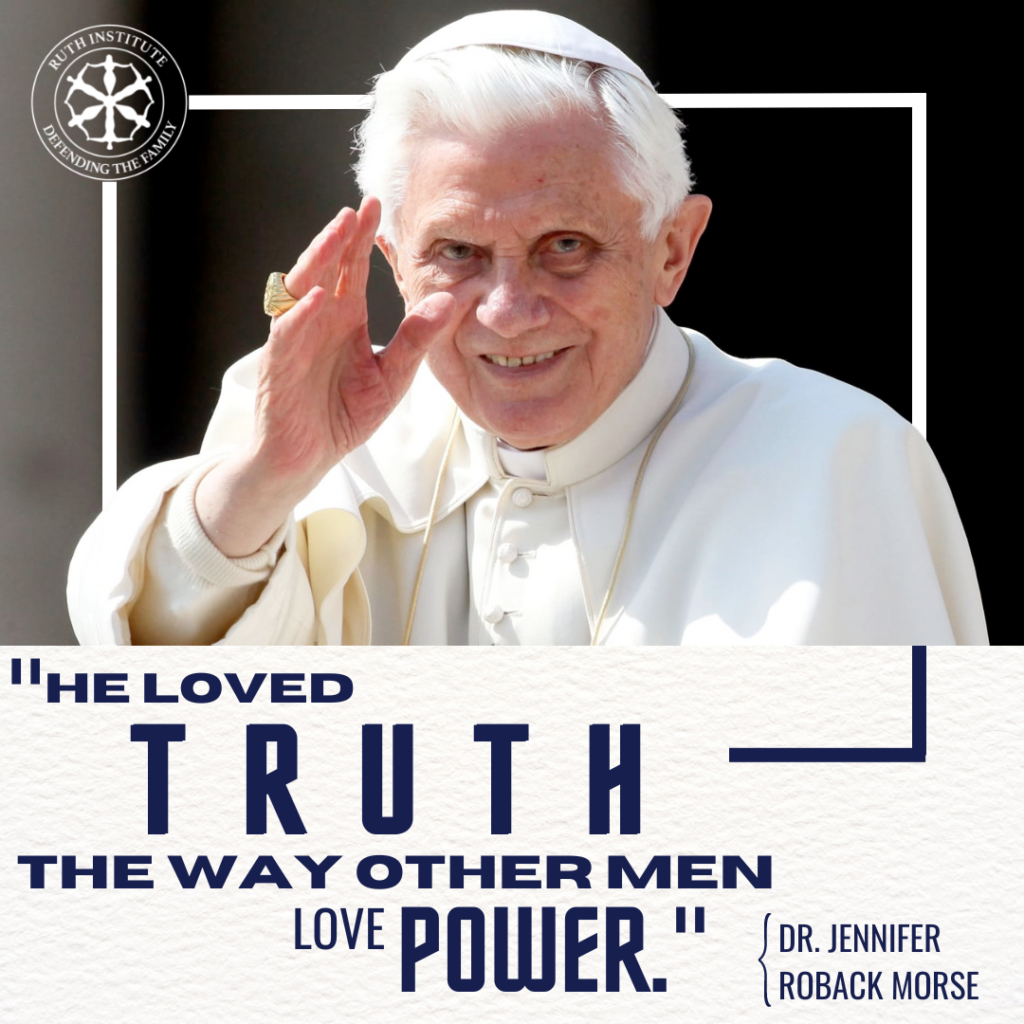
COMMENTARY: While his handling of clergy sexual abuse and his unprecedented resignation from the papacy give rise to legitimate criticisms, on balance he made a positive contribution in both cases.
Jennifer Roback Morse January 3, 2023 at National Catholic Register
Two themes dominate the assessment of Cardinal Joseph Ratzinger, Pope Benedict XVI’s life and pontificate: first, his handling of clergy sex abuse in the Catholic Church and, second, his resignation. As to the first point, I, too, wish he had done more to combat clergy sexual abuse inside the Catholic Church. However, I am hard-pressed to name anyone of his stature who has done more than he did.
As to his resignation, far too many leaders grasp and abuse power, in all the major authority structures of society, literally left and right. Around the world, inside and outside the Church, people use the power of their offices to enrich themselves, promote their agendas and cover their crimes. In this worldwide cesspool of corruption, Benedict XVI walked away from the most powerful office on earth, the office of the Vicar of Christ. As painful as his resignation has been, we can, if we will, see the hand of God at work. Benedict’s resignation set in motion a series of events whose end is not fully known. I believe we have reason to be hopeful that the ultimate result will be constructive.
His work on clergy sexual abuse predates his election to the papacy. According to a New York Times report upon his accession to the papacy in 2005, Cardinal Ratzinger had made a weekly practice of reading through dossiers on accused priests, a practice he referred to as “our Friday penance.” An Associated Press review of Vatican records in 2014 dates Ratzinger’s procedural improvements to 2001, stating that they show a “remarkable evolution in the Holy See’s in-house procedures to discipline pedophiles.” The AP continued, “Then-Cardinal Joseph Ratzinger took action after determining that bishops around the world weren’t following church law to put accused clerics on trial in church tribunals.” Between 2011 and 2012 alone, Pope Benedict laicized nearly 400 priests. By one estimate, he was responsible for the laicization of more than 800 priests between 2004 and 2014, and he disciplined many more. Benedict was the person who finally sanctioned the heinous Marcial Maciel, the founder of the Legionaries of Christ.
During his many trips around the world, he met with numerous victims, one of whom was Faith Hakesley, who was raped by her parish priest as a teenager. Her meeting with Benedict was deeply meaningful for her and continues to bear spiritual fruit. She currently writes the “Ask a Survivor” column for the Ruth Institute.
As is fitting for a man of his intellectual gifts and stature, the pope emeritus wrote an important essay in 2019 on the intellectual antecedents of the clergy sex-abuse crisis: the sexual revolution of the 1960s and its influence within Catholic seminary formation. Numerous Catholics sympathetic to the sexual revolution tried to deflect attention from the important and obvious points he was making. “Embarrassing,” they said. Clergy sex abuse predated the sexual revolution, they said. The John Jay Report says homosexuality has nothing to do with clergy sex abuse. And so on. The mainstream legacy media lost no time amplifying this subset of Catholic opinion and blasting it to the wider culture.
If anyone in those media outlets had asked my opinion (which they didn’t), I would have told them the pope emeritus was substantially correct. (I outlined how in a recent Register column!) Around the same time as Benedict published his essay, the Ruth Institute published a far-reaching study on clergy sex abuse in the Catholic Church. Father Paul Sullins, the senior research associate at the institute, extended earlier work all the way through 2017 based on the John Jay Report data, the Pennsylvania Grand Jury Report, and other previously untapped data sources. Father Sullins posed this question: Is the date of ordination related to clergy sex abuse? That is, are some ordination classes systematically more likely to have predators?
His thorough analysis shows a disproportionate percentage of abusing priests were ordained in two time periods: the late 1960s and the early 1980s. (The “Executive Summary,” Item 8 and pages 18-19 of the study provide details.) The first wave of abusers was ordained at exactly the period Benedict identified, the late 1960s. The men ordained in the second wave, the early 1980s, were trained in the last period prior to John Paul II taking the helm.


